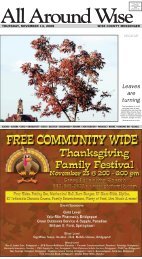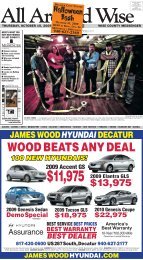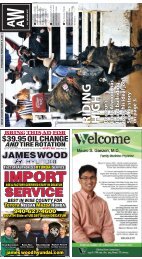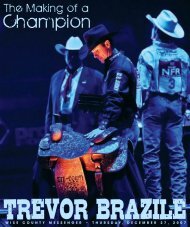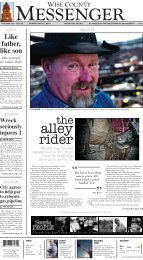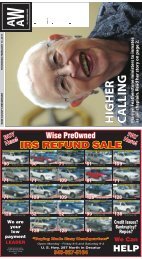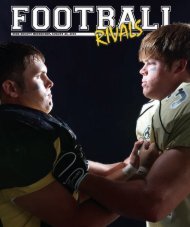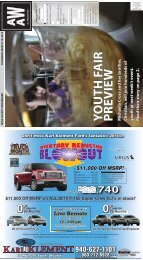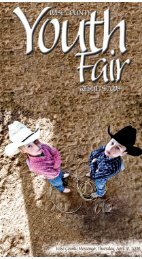2009 Welcome to Wise.indd - Wise County Messenger
2009 Welcome to Wise.indd - Wise County Messenger
2009 Welcome to Wise.indd - Wise County Messenger
Create successful ePaper yourself
Turn your PDF publications into a flip-book with our unique Google optimized e-Paper software.
WISE COUNTY His<strong>to</strong>rical Markers<br />
Alvord Lodge No. 512, A. F. & A. M.<br />
113 N. Wickham Street, Alvord<br />
Prominent founding member R. W. Johnson<br />
led efforts <strong>to</strong> organize Audubon Masonic Lodge<br />
No. 512 in the village of Audubon (seven miles<br />
northeast) in 1879. The lodge moved <strong>to</strong> Alvord in<br />
1886 where members built a second floor on<strong>to</strong> a<br />
schoolhouse <strong>to</strong> use as a lodge hall. The name was<br />
officially changed <strong>to</strong> Alvord Lodge in 1890, and in<br />
1991 a new two-s<strong>to</strong>ry s<strong>to</strong>ne lodge hall was erected<br />
at this site. The Masons met on the second floor<br />
and a local bank rented the first floor until 1984.<br />
The lodge continues a tradition of public outreach<br />
<strong>to</strong> the Alvord community.<br />
Aurora Cemetery<br />
About 1/2 mile south of FM 114 on Cemetery<br />
Road in Aurora.<br />
The oldest known graves here, dating from as<br />
early as the 1860s, are those of the Randall and<br />
Rowlett families. Finis Dudley Beauchamp (1825-<br />
1893), a Confederate veteran from Mississippi,<br />
donated the three-acre site <strong>to</strong> the newly formed<br />
Aurora Lodge No. 479, A.F. & A.M., in 1877. For<br />
many years, this community burial ground was<br />
known as Masonic Cemetery. Beauchamp, his wife<br />
Caroline (1829-1915), and others in their family are<br />
buried here. An epidemic which struck the village in<br />
1891 added hundreds of graves <strong>to</strong> the plot. Called<br />
“spotted fever” by the settlers, the disease is now<br />
though <strong>to</strong> have been a form of meningitis. Located<br />
in Aurora Cemetery is the graves<strong>to</strong>ne of the infant<br />
Nellie Burris (1891-1893) with its often-quoted<br />
epitaph: “As I was so soon done, I don’t know why I<br />
was begun.” This site is also well known because of<br />
the legend that a spaceship crashed nearby in 1897<br />
and the pilot, killed in the crash, was buried here.<br />
Struck by epidemic and crop failure and bypassed<br />
by the railroad, the original <strong>to</strong>wn of Aurora almost<br />
disappeared, but the cemetery remains in use with<br />
over 800 graves. Veterans of the Civil War, World<br />
Wars I and II, and the Korean and Vietnam conflicts<br />
are interred here.<br />
Indian Captives Dot and Bianca Babb<br />
From Chico, take FM 1810 about two miles<br />
east <strong>to</strong> marker<br />
Two of Texas his<strong>to</strong>ry’s best-known Indian captives,<br />
13-year-old T. A. “Dot” Babb (1852-1936)<br />
and his 9-year-old sister Bianca (1855-1950) were<br />
s<strong>to</strong>len by Comanches from their home near here in<br />
September 1865. While at play one day, the children<br />
were surprised by a raiding party of 35 <strong>to</strong> 40 Native<br />
Americans. Mrs. Babb was killed and Dot, Bianca<br />
and Mrs. Luster (a visi<strong>to</strong>r) were taken <strong>to</strong> Indian Terri<strong>to</strong>ry<br />
(present Oklahoma). After helping Mrs. Luster<br />
escape on the way, Dot was very nearly executed,<br />
but so s<strong>to</strong>ic was he in facing death that the Native<br />
Americans admiringly spared his life. For the next<br />
two years Dot and Bianca lived, in different tribes,<br />
as adopted Comanches. Bianca later recalled that<br />
the Native Americans held a feast - with coffee, a<br />
luxury - upon her arrival and that they colored her<br />
blonde hair with charcoal and buffalo tallow. Dot,<br />
after a winter as the squaws’ flunky, asserted his<br />
male rights and thereafter spent his time taming<br />
horses. He was taken on raids against other tribes<br />
and showed signs of becoming a fine warrior. After<br />
two years, the children’s father ransomed them and<br />
a joyful reunion occurred. Both Dot and Bianca<br />
spoke with sympathy, however, of many Indian cus<strong>to</strong>ms<br />
and of kind treatment during captivity.<br />
Toll Bridge and Old Bridgeport<br />
West of Bridgeport at FM 920 and Trinity River<br />
Bridge<br />
When Butterfield Overland Mail traversed this<br />
area (1858-61) on St. Louis <strong>to</strong> San Francisco route,<br />
a crossing over West Fork of the Trinity was a necessity.<br />
Colonel W. H. Hunt on Feb. 11, 1860, obtained<br />
a charter and built a <strong>to</strong>ll bridge here (50 yards<br />
west). The Overland Mail ceased operating as Civil<br />
War began. The bridge soon collapsed. However,<br />
a settlement had begun here, and in 1873 Charles<br />
Cates, a Decatur merchant, spanned the river with<br />
an iron bridge. When the Rock Island Railroad built<br />
<strong>to</strong> this point in 1893, <strong>to</strong>wn moved but retained<br />
his<strong>to</strong>ric name.<br />
Bridgeport Coal Mines<br />
Located at 8th and Hovey Streets, Bridgeport<br />
Once a staple of Bridgeport’s economy, coal was<br />
discovered here in later part of 19th century. Diggers<br />
hit vein 60 feet deep while seeking water. Mine<br />
No. 1 lies under northeast Bridgeport, and entire<br />
area is honeycombed with tunnels and shafts.<br />
<strong>Wise</strong> <strong>County</strong> Coal Company was chartered Aug. 23,<br />
1882, by C. D. Cates, J. C. Carpenter, J. G. Halsell, J.<br />
J. Lang, H. Greathouse, and D. Waggoner. The firm<br />
was bought in 1900 by Colonel William H. As<strong>to</strong>n of<br />
Virginia. Renamed Bridgeport Coal Company, it had<br />
500 employees at Zenith. Mines closed in 1929 due<br />
<strong>to</strong> increased use of oil and gas.<br />
Bridgeport Lodge No. 587, A.F. & A.M.<br />
Located at 1012 Halsell Street -Bridgeport<br />
On Dec. 12, 1884, the Bridgeport Masonic Lodge<br />
was granted a charter by the Grand Lodge of Texas.<br />
The 27 charter members consisted primarily of local<br />
coal miners, ranchers and businessmen. The group<br />
met in a tin building on the old Town Square until<br />
about 1900, when a second building was completed.<br />
A two-s<strong>to</strong>ry brick building was purchased from<br />
Dr. K. L. Buckner in 1925. From its beginning the<br />
lodge has been active in community affairs, with its<br />
membership providing civic leadership and support<br />
for local public schools.<br />
Brown Hotel<br />
East Decatur Street, Chico<br />
Located one block east of Chico’s public square,<br />
the Brown Hotel was developed in several stages<br />
beginning in 1888 and lasting through 1910. The<br />
Brown Hotel exemplifies the type of lodging once<br />
found in numerous small Texas <strong>to</strong>wns near the turn<br />
of the century. In 1876 J.T. Brown, builder of the<br />
hotel, purchased the land on which Chico is located<br />
from R.C. Mount. That year the <strong>to</strong>wn of Chico was<br />
laid out by Brown, an immigrant from Chico, Calif.,<br />
near Dry Creek, a tributary of the West Fork of the<br />
Trinity River. Over a decade later, Brown built his<br />
hotel near the public square. Although another<br />
hotel, The Chico, which no longer stands was built,<br />
the Brown Hotel was an important social center for<br />
the community. In about 1908, R.L. Morris, a banker<br />
from Mississippi, purchased the hotel. Morris, who<br />
established a bank and mercantile s<strong>to</strong>re in Chico,<br />
retained ownership of the hotel until his death in<br />
1965. He made the hotel his permanent residence.<br />
Butterfield Overland Stage Line<br />
Marker located at north city limits on Old US<br />
81/287, Decatur<br />
Through Decatur passed the Butterfield Overland<br />
mail line connecting St. Louis and San Francisco<br />
with semi-weekly stage and mail service, 1858-<br />
1861. The length of the route, 2,795 miles and the<br />
superior service maintained made this a pioneer<br />
enterprise of the first magnitude.<br />
Decatur Baptist College<br />
1602 S. Trinity St., Decatur<br />
The Administration Building of the Decatur<br />
Baptist College is a three-s<strong>to</strong>ry limes<strong>to</strong>ne building<br />
situated on a hill overlooking the <strong>to</strong>wn of Decatur<br />
decicated Sept. 6, 1893. The Northwest Texas Baptist<br />
Association, composed of 138 Baptist Churches<br />
in five counties in northwest Texas, founded Northwest<br />
Texas Baptist College in Decatur in 1891. During<br />
the 1892-1893 session, the college held classes<br />
in the opera house above a grocery s<strong>to</strong>re in Decatur.<br />
By the second year the Administration Building was<br />
completed. The Administration Building, a Vic<strong>to</strong>rian<br />
structure with certain castellated Romanesque<br />
features, contains 15 rooms and a chapel.<br />
During the second school year, the college had<br />
an enrollment of 149 students and a faculty of<br />
eight. The school became bankrupt in 1896 due <strong>to</strong><br />
the failure of the supporting churches <strong>to</strong> pay their<br />
pledges and in the fall of 1897, the Texas Baptist<br />
Convention purchased and operated the school,<br />
changing the name <strong>to</strong> Decatur Baptist Junior College.<br />
This junior college founded in 1897 was the<br />
first private junior college in the United States. Its<br />
primary function was as a prepara<strong>to</strong>ry school for<br />
Baylor University. In 1964 the college was moved <strong>to</strong><br />
Dallas and became Dallas Baptist College.<br />
The building now serves as the <strong>Wise</strong> <strong>County</strong><br />
Heritage Museum.<br />
Decatur First United Methodist Church<br />
104 S. Miller, Decatur<br />
Organized in 1862, this congregation is the oldest<br />
in Decatur. The Rev. J. R. Bellamy conducted the<br />
first services in a vacant s<strong>to</strong>re on the south side of<br />
the <strong>to</strong>wn square. Other churches were not started<br />
in the community until after the Civil War. The<br />
first sanctuary was constructed at this site in 1881.<br />
Property for the congregation was deeded by the<br />
county government. Built during the pas<strong>to</strong>rate of<br />
the Rev. E. D. Dejernet, the edifice was destroyed<br />
by fire in the early 1890s. A second church structure<br />
for the fellowship was soon built at this location. It<br />
served the growing membership until the present<br />
brick sanctuary was completed. Constructed under<br />
108




